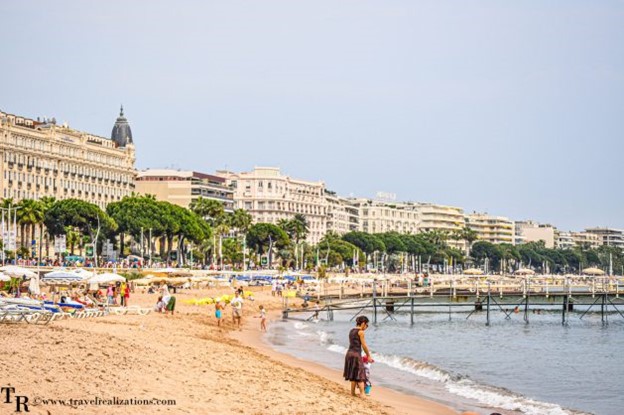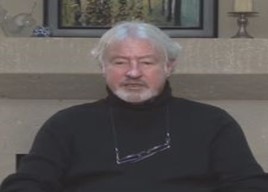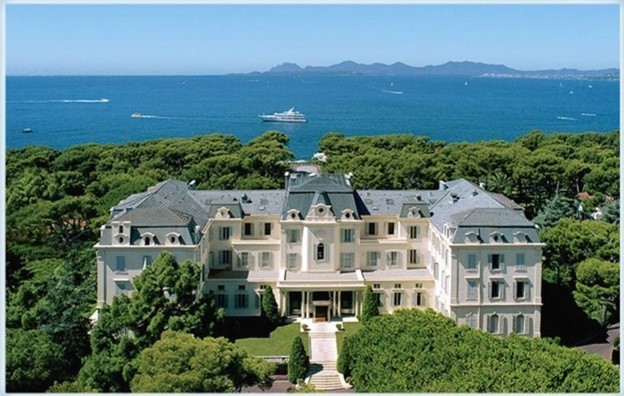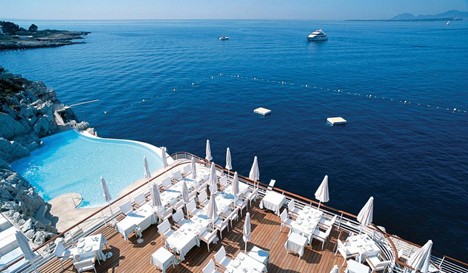

Author: Kent Moors, Ph.D.
Today’s Spy Tale involves events that occurred later in my career. Once again, it shows how one of my lives would often merge into another.
It also involves the period in which I got to play “movie mogul.”
Each May from 2003 through 2008, Marina and I attended the Cannes Film Festival on the Mediterranean French Riviera. The premier annual meeting for the film industry and the stars pushing their newest releases, it was always a memorable ten-day event (or as much as you could remember of it).
The private parties were legendary and required some training in advance. You needed to be able to go without sleep while keeping up with those having far more experience “imbibing.” But if you had entry permission, it may be the only occasion in which one could mingle with the rich and famous without pretension. Everybody in the room (or on the yacht, or in the club “closed for a private function”) was supposed to be there and that made for a surrealistic experience.


In those days I was still holding down a professoriate as my “day job” (I would continue doing so until retiring from the university at the end of 2013), but my other life was transitioning from primarily intelligence operations to global advising.
Of course, it was never absolutely certain where one ended and the other began. After all, there was no expiration date on what Uncle Sam could expect from me. In addition, the international advising gigs provided as ready (or better) cover than did academe if some intel matters came up.
As one did on the occasion of this Spy Tale entry.
This tale begins at the Cannes gathering in 2003 but plays out more seriously at the Film Festival the following year.
As usual, some background up front.
While I was living in London in the 1980s, I was introduced to film maker John Daly at a party. John (who died in 2008) was half of the legendary production team making up Hemdale (the other half was British actor David Hemmings).


Hemdale was founded in 1967, becoming probably the most famous independent movie production house for over two decades between 1972 and 1997.
Rumor had it that John and David set up Hemdale to provide British actors an escape route from paying 90 percent (or more) of their income to UK Inland Revenue. That route involved reinvesting what was made on one film into the production of others.
Hemdale attracted the biggest and brightest performers, directors, editors, and script writers. There are no Oscars given to producers. But Hemdale-produced films garnered 21 Oscar nominations and 13 wins in various categories, including the only back-to-back Best Picture winners from the same producers (Platoon in 1987 and The Last Emperor in 1988). Other films included the first Terminator, Hoosiers, Tommy, The Falcon and the Snowman (for which I served as an advisor), Salvador, The Return of the Living Dead, and about 100 others.
Hemdale also produced dozens of plays and musicals worldwide, including Oliver! and Grease.
By the time we started working together again seriously (late in 2002), John was heading up Film and Music Entertainment, Inc. (FME) out of a suite of offices in a legendary Los Angeles movie location – 5670 Wilshire Blvd.
John had been experimenting with several new approaches but had been drawn back to an innovative formula he first used with The Last Emperor. The idea was to produce a lavish movie on location, attract a world famous director, center the script about a well-known Western movie star (Peter O’Toole in Emperor), and populate the rest of the main cast with up and coming local talent who were unknown abroad. But there would be no dubbing. All lines had to be spoken in English. No less than five of the locals in Emperor would go on to become big stars in US movies and television.
The Last Emperor was the first Western feature film the government in Beijing allowed to be made inside the Forbidden City. It was a critical and box office smash hit. In addition to Best Picture, it also won Bernardo Bertulucci the Director’s Oscar, along with seven other academy awards.
John had been spending time in Russia and decided he wanted to use the same formula to make movies in Moscow. One afternoon, he and a member of his staff contacted me and after three hours of kicking matters around, I agreed to advise on financing such Emperor clones and others being contemplated of a more traditional variety.
Of course, Marina was delighted. This was something we could do together and in her native Moscow no less. That it would involve some folks at the Mosfilm studios in the Lenin Hills overlooking the city, close to where we had lived for a time, hardly hurt either. If she needed any further encouragement, the final straw was by telephone. John had Bruce Willis call and invite her to the official opening of Planet Hollywood (PH) in Vegas.
Willis and Silvester Stallone were the primary investors in the PH transition from what had been called The Aladdin. While Marina would party, John, some of his partners (including actors Martin Landau and James Woods), a couple of bankers, and I would work on the production model.
Now that PH opening would be a story in itself. Among other things, there was the episode in which Marina beat Meg Ryan in a drinking match again (the first had been at that year’s Cannes Festival where Meg happened to be a judge; we had to “support” her walking up the red carpet after a night of partying). Meg is a demure blonde from Connecticut; Marina is a Russian. Hardly a fair contest.
And then this Vegas adventure was also the time I narrowly avoided investing in a real estate deal off the Strip with Danny Devito. The project went bellyup, fortunately without my money going with it.
But back to Cannes. John had set up a series of meetings with studios to discuss the reprise of The Last Emperor model, this time with Russian settings and cast. The basic Hemdale approach had been to bring in other marquis companies like TriStar, Orion, and United Artists to share costs and distribution.
This time around, we met with a new generation of potential partners, including Miramax, Lionsgate, Columbia TriStar, Universal, Oak Productions (Arnold Schwarzenegger’s production company), and members of the Paramount Pictures/Warner Brothers ad hoc group built around Jerry Bruckheimer.
But developing funding avenues was our primary emphasis at Cannes 2003. We needed to gather a war chest before pitching the Russian idea seriously.
Several shells were established to run P&A (print and advertising) budgets for films seeking help to close out overextended production budgets. I would incorporate in the Bahamas one of these for each film we would work on. It turned out this would be profitable for both FME and ASIDA (my consulting company).
I knew nothing about the business and will never understand “creative” Hollywood accounting, but we early on realized we had something. I thought the “P” in “P&A” simply meant a kind of print advertising. Wrong. At the time, this stood for how many prints of a film would be included in the budget. At $5,000 each, these prints determined how many screens a movie could be released on. For entries coming out in the summer rush, the number of screens was crucial because at best a movie would have two weeks before another major competitor would emerge.
As it turned out, similar problems resulted from having little budget space for the first round of general advertising that often determined what box office a summer release could expect before it became history. Star Wars may be the only blockbuster ever to make it largely by word of mouth.
If a movie did not have a huge distribution deal locked up (and most showing at Cannes do not), producers are desperately looking for final funding at the Festival. That is why they are there. John and I would spend most of our time screening movies searching for vehicles that would benefit from last minute investment.
For films we thought had a chance, FME and a group of investors put together by ASIDA would agree to structure a P&A package as last funding in, first payment out. Given that most versions of films presented at Cannes are not finished – not anywhere near a final theatrical cut – this would usually make for some difficult judgments.
But it also brought about some unanticipated interest. Schwarzenegger was there in 2003 touting Terminator 3. At the time, this was the most expensive movie ever budgeted and it was approaching its release version flat broke. It needed a P&A infusion and quick.
And then there was the Bruckheimer entourage. 2003 was the Cannes in which they were unveiling the first of what would become a very profitable franchise (Pirates of the Caribbean: The Curse of the Black Pearl). But it was beset with significant budget problems, a nasty disagreement between director and some of the production group, and a terribly edited screening version. Its P&A space was even worse.
I realized we were going to make some quick money when a request was made from both groups. John, Marina, and I even had lunch with Arnold over this. Marina was late and ran around a corner literally bouncing off Schwarzenegger. He didn’t even budge.
All of our meetings and business meals took place in our hotel, the most important and private venue at Cannes. This is the fabled Hotel du Cap-Eden-Roc located in Antibes less than eight miles up the coast from the center of Cannes:


Everybody who is anybody stays here. The hotel is located on a self-enclosed expanse of land completely walled in and closed to the public. It has its own security force and the paparazzi are strictly forbidden.
Here the famous (and not so famous people like me) can walk the grounds without having to sign an autograph or be besieged by fans.
There have been a number of remarkable memories from the parties there. But my favorite has to be Cannes 2007 when Clooney, Pitt, Damon, and the ten other stars from Ocean’s Thirteen were all staying there. You could walk right up and say bonjour.
Our meetings would usually take place in the Eden-Roc Restaurant with its famous view of the Mediterranean. While one of the most gorgeous locations I have ever seen, there is also a bit of somber history. The restaurant is high up on a multi-tiered site rising from the ocean. The location served as Gestapo headquarters for the south of France during World War II.


The hotel is not without its quirks. For the first several years we would need to wire the fees before hand. Hotel du Cap did not accept credit cards until 2006.
And then there are the fees themselves. For the Festival you must book a stay for all ten nights whether you plan to be there for the entire time or not. It is outrageously expensive. Each year we would take a “traditional room,” 270 square feet facing the gardens. During our final stay in 2008, that cost me $49,000 and change! On one occasion, I noticed that the luncheon menu in our meeting restaurant had no dishes costing less than an equivalent of $275, while a small bottle of Coca-Cola would set you back $36. Fortunately, all meals were covered by a budget FME had set up beforehand.
OK preliminaries out of the way, this is what happened. In our 2003 meetings, it became clear that an unusual amount of “loose” finance was floating around looking for film projects. This was not normal. Usually, the situation called for the projects to chase the money.
Now there were always some Saudi and related checkbooks looking to bankroll movies having certain themes. But that was compartmentalized and either directed to subjects related to regional politics or movies starring endowed young ladies.
In 2003, there were wide rumors about new money coming on the scene. But nothing surfaced, adding to the frustration of small film makers on their last dimes and the rising curiosity of most everybody else.
It appeared that unknown parties were “sounding out” film makers and independent producers but appeared not ready to move. No “phantom” money was laid out in 2003. That would not be the case in a year.
By midweek, John came rushing into a meeting and pulled me aside. “According to the Mosfilm crowd,” he exclaimed, “the phantom money is Russian.” As far as he was concerned, suddenly, The Last Emperor Moscow style was back on the table.
The problem was there was no script or even a laid out concept board to work with. That would take a year and end up with a movie entitled The Petersburg-Cannes Express shot in Russia and screened at the 2004 Cannes Festival. John would direct.
For my part, the Russian money became a focus. The agency was also interested in whether certain ex-Soviet players salting away fortunes from flipping former USSR state assets were now looking at financing foreign films as a way to launder some of that loot.
There was also an earlier example for those like me old enough to remember. From 1955 until 1959 British ITV ran The Adventures of Robin Hood. Richard Greene played Robin and became a huge star while the series was the first major international syndicated TV hit.
For the final three years of its run it was financed by the American Communist Party through several cut out shells.
So while John was feverishly working on a script with Mosfilm and a group of Russian set technicians and actors, I oversaw the laborious process of tracing what was discussed at Cannes when the Russian money came up and the follow on conversations once the Festival was over.
Here, we created a “phantom” of our own. It was called Destiny Pictures and was based in a vacant office in Rosslyn, VA just over the Key Bridge from Georgetown and DC. The phones were answered remotely. A few years later it had to be quietly shelved when a real independent production company in Hollywood was founded using the same name.
Still, from 2003 through early 2006, our venture produced no movies but tapped into the network surrounding the Russian money. A full op was approved and rolled out with a connection to ASIDA as an interested funding partner. When Cannes 2004 came, we were ready to parallel the FME-ASIDA work there with some of our own. John had spent much of the intervening year in Russia finishing his movie and was not privy to what Destiny was doing. That was hardly unusual, given the often unstructured way Hollywood operates.
Prior to Cannes 2004, Destiny and ASIDA took out adds in the trade papers announcing a joint effort intending to compile US-Russian-Eastern European cinema projects for financial support with discussions being scheduled for Cannes.
Two initial statements of interest were fielded by the Roslyn office before I left for Cannes on May 10 (the festival began on May 12 that year). John regarded what I was doing as a “side interest,” having little to do with our other business at hand.
By the time we assembled at the Hotel du Cap, The Petersburg-Cannes Express was nearing completion, although the version screened still had a lot of work in front of it. It was finally premiered at the Palm Springs International Film Festival and sank like a rock.
I was introduced to the film’s main Russian bankrollers, but they had no connection to the folks “the office” wanted to focus upon. John’s guys had never been to Cannes and had money coming from retail and commercial sources other than the ones we were looking at.
Still, I had been able to put together some outside investment interest for Express and that allowed me to parlay that into what John and I had in mind for the overt activities at Cannes.
Meetings were held with several interested Russian parties during Cannes 2004 and the indications were clear that this time around they came ready to commit. Some of these conversations could segue into John’s movie plans (giving some authenticity to what I was doing for my “other project”).
Yet I had to be careful. In talking to the Russians, I was soliciting intel but did not have any acual movie ventures to fund. Of course, the movie business involves a lot of talking, usually over lunch, with often nothing to show for it. Even at Cannes.
Some leads were obtained nonetheless and the info was fed into a much larger data base. A few years later, those leads would center about these same Russians being involved in upscale London real estate purchases, allowing a better understanding of how designated individuals were moving money out of Russia.
John never made another movie in Russia, although he did direct two later movies – The Aryan Couple (starring Martin Landau) and Love at First Kill (with Margot Kidder). We had some further dealings in 2006 when John brought me along to Austin for discussions with then Texas Governor Rick Perry about establishing a studio in Texas and shooting films there. And then there was what became annual May gatherings at Cannes.
In 2008, John had become a shadow of himself as the cancer took over. It is tradition at the Festival for theme music from Oscar winners to be played continuously over the main beach strip. I remember walking the beach with John one night while music from both Platoon and The Last Emperor played in the background.
He died on October 31 of that year at Mount Sinai in Los Angeles. Marina and I decided that Cannes no longer had as much fascination. We have never gone back.


This is an installment of Classified Intelligence Brief, your guide to what’s really happening behind the headlines… and how to profit from it. Dr. Kent Moors served the United States for 30 years as one of the most highly decorated intelligence operatives alive today (including THREE Presidential commendations).
After moving through the inner circles of royalty, oligarchs, billionaires, and the uber-rich, he discovered some of the most important secrets regarding finance, geo-politics, and business. As a result, he built one of the most impressive rolodexes in the world. His insights and network of contacts took him from a Vietnam veteran to becoming one of the globe’s most sought after consultants, with clients including six of the largest energy companies and the United States government.
Now, Dr. Moors is sharing his proprietary research every week… knowledge filtered through his decades as an internationally recognized professor and scholar, intelligence operative, business consultant, investor, and geo-political “troubleshooter.” This publication is designed to give you an insider’s view of what is really happening on the geo-political stage.
You can sign up for FREE to Classified Intelligence Brief and begin receiving insights from Dr. Moors and his team immediately.
Just click here – https://classifiedintelligencebrief.com/






